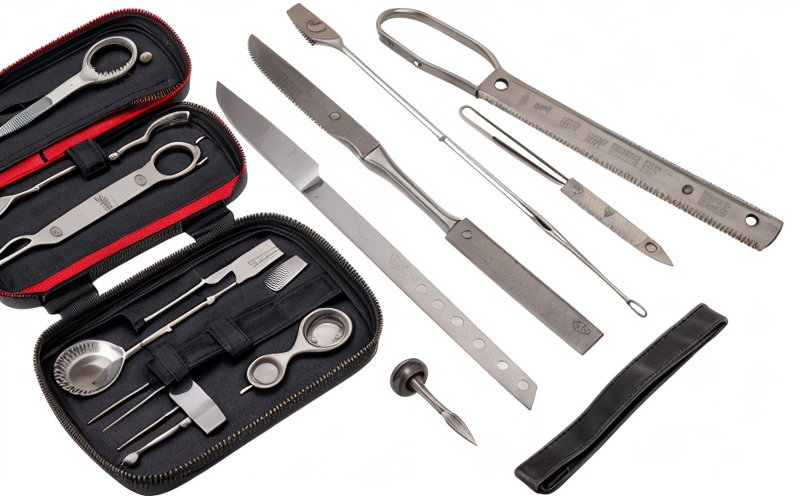Dimensional Verification Testing of Minimally Invasive Surgical Tools
Dimensional verification testing is a critical process in ensuring that medical devices meet regulatory and safety standards. For minimally invasive surgical tools, precise dimensions are essential for proper function and patient safety. This service ensures that the dimensions of surgical instruments align with design specifications and international standards such as ISO 13485, ISO 10993, and ASTM F739.
Minimally Invasive Surgery (MIS) involves procedures where surgeons operate through small incisions. The precision required in this field demands rigorous testing of surgical instruments to ensure they fit precisely into anatomical spaces and function correctly during the procedure. For instance, tools like trocars, graspers, scissors, and dissectors must have dimensions that are not only accurate but also consistent across production batches.
The process begins with a thorough review of design specifications from our clients. This information is used to calibrate the testing equipment to ensure that it can accurately measure critical dimensions such as length, width, depth, and curvature. Once calibrated, we use advanced metrology instruments like CMMs (Coordinate Measuring Machines), micrometers, and laser scanners to conduct detailed measurements.
The specimens for testing are prepared by our team according to the specific requirements of each tool type. This includes cleaning, sterilization if necessary, and positioning the instrument in a manner that simulates real-world use conditions. The data collected from these tests is then analyzed against the design specifications to identify any discrepancies or deviations.
The results of the dimensional verification testing are reported comprehensively, highlighting any areas where there may be a need for adjustment or improvement. Our reports include detailed charts and graphs for visual representation and are accompanied by recommendations on how to address any issues identified during the testing process. This ensures that our clients can make informed decisions about their product development processes.
By providing accurate and reliable dimensional verification, we help ensure patient safety and regulatory compliance. Misalignment or improper dimensions in surgical tools could lead to serious complications for patients undergoing minimally invasive procedures. Therefore, this service plays a crucial role in maintaining quality standards within the medical device industry.
Applied Standards
The dimensional verification testing of minimally invasive surgical tools is guided by several key international standards designed to ensure product safety and performance. These include:
- ISO 13485: Quality Management System for Medical Devices – This standard provides requirements for a quality management system applicable to medical device manufacturers, including those involved in the design and development, production, control, inspection, installation, and servicing of medical devices.
- ASTM F739-18: Standard Practice for Dimensional Verification of Surgical Instruments – This ASTM standard specifies the procedures for verifying the dimensions of surgical instruments to ensure they meet specified tolerances and are suitable for their intended use.
- EN ISO 10993-2: Biological Evaluation of Medical Devices Part 2: Biological Test Methods – While primarily focused on biological evaluation, this standard includes considerations that indirectly affect dimensional accuracy in relation to material compatibility and biocompatibility.
The application of these standards ensures consistency across testing procedures and provides a framework for quality assurance. By adhering to these guidelines, we can provide accurate and reliable test results that meet regulatory requirements and industry expectations.
Environmental and Sustainability Contributions
In addition to ensuring the precision of surgical instruments, our dimensional verification testing contributes positively to environmental sustainability efforts in several ways:
- Energy Efficiency: Our facilities are equipped with energy-efficient equipment that minimizes resource consumption during testing processes.
- Waste Reduction: By using advanced metrology instruments and efficient specimen preparation techniques, we reduce waste generation associated with the testing process. This includes minimizing the use of unnecessary materials and ensuring proper disposal of any by-products generated.
- Resource Conservation: Our testing methods are designed to conserve resources such as water and electricity, contributing to overall environmental stewardship.
We also encourage our clients to consider sustainable practices in their product development processes, providing advice on how to design products that are more environmentally friendly without compromising quality or performance. By integrating these practices into the manufacturing process, we contribute to a greener future for healthcare technology.
Use Cases and Application Examples
The dimensional verification testing of minimally invasive surgical tools has numerous practical applications across different medical device manufacturers and hospitals. Here are some examples:
- Tool Calibration: Before a new batch of surgical instruments enters production, calibration tests ensure that the manufacturing process is consistent with design specifications.
- Benchmarking: Comparing test results against previous batches helps identify trends and areas for improvement in product quality over time.
- Failure Analysis: When a tool fails to function properly during surgery, dimensional verification tests can help pinpoint the cause of failure, whether it be due to manufacturing errors or design flaws.
- Training and Education: Our testing results are also used in training programs for surgeons and medical staff, ensuring they understand how to use tools correctly and safely.
- Regulatory Compliance: Ensuring that all surgical instruments meet regulatory standards is crucial for compliance with international guidelines like FDA, CE Marking, and others.
- Risk Management: Identifying potential risks early in the development process through dimensional verification testing helps mitigate hazards associated with misaligned tools during surgery.
- Product Development: Continuous testing ensures that new products are developed to meet high standards of precision and reliability, enhancing overall product quality.
These use cases demonstrate how dimensional verification testing is integral to maintaining the integrity and effectiveness of minimally invasive surgical tools. By leveraging this service, medical device manufacturers can enhance patient safety and improve surgical outcomes.





